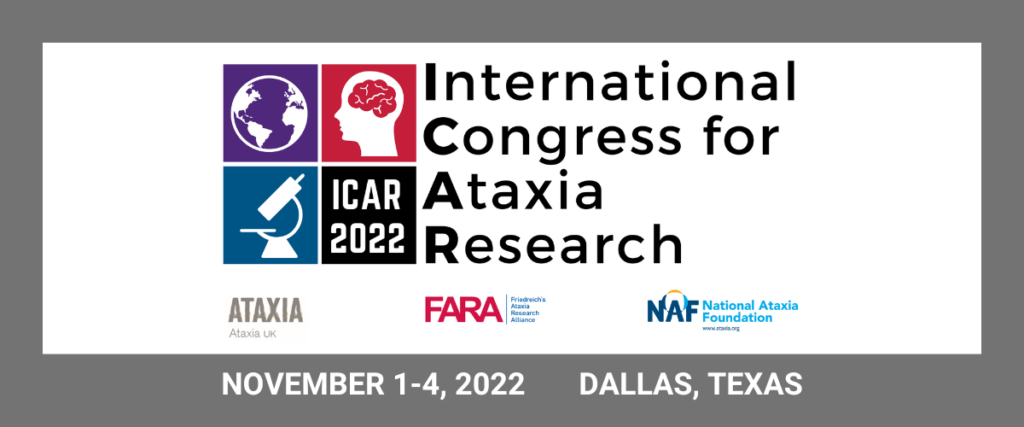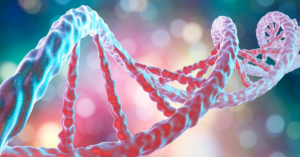
Written by Dr. Ronald Buijsen
Edited by Celeste Suart
The Late Breaking Session presented data on new insights into FA disease mechanisms and positive results in an FA omaveloxolone clinical trial, a novel SCA5 screening platform to identify new drug targets & the discovery of a novel gene causing SCA50.
During the last and most important session of this meeting early career ataxia researchers featured Flash Talks understandable for lay audiences. Jarmon Lees presented his research on blood flow in FA and was chosen as the best presenter.
The last day of the ICAR2022 meeting started with the “late-breaking session”. A late-breaking session contains new information that is not yet known or fully available at the time the program for the meeting was finalised. Late-breaking talks present data that are high-impact, ground-breaking, innovative, and newsworthy. Due to the nature of this session, it covered multiple topics that were already discussed throughout the meeting.
- Sanjay Bidichandani shared research on why a some Friedreich’s ataxia patients have fewer disease symptoms compared to others. He also discussed how this information might help in exploring new treatments.
- David Lynch presented how data of Friedreich’s ataxia patients from a natural history study can be used to analyse the effect of a new drug in a clinical trial. A natural history study measures how disease symptoms change over time without any treatment. Measurements of symptoms are tracked from the disease’s onset until either the symptoms get better or the patient’s death. Its purpose is to identify demographic, genetic, environmental, and other variables that correlate with the disease’s development and outcomes. Currently, Reata Pharmaceuticals is performing a clinical trial for omaveloxolone, an potential drug for the treatment of Friedreich’s ataxia patients. Recently, a comparison of the data from the patients treated with omaveloxolone and the untreated patients was performed. The data on omaveloxolone is promising, showing long term benefits to patients in the study. More research is needed in this area before omaveloxolone is more widely used, but the outlook is hopeful.
- Adam Avery explained how a drug screening platform is being used to identify new therapeutic approaches to treat spinocerebellar ataxia type 5 (SCA5). A specific mutation linked to SCA5 causes a protein called actin to bind to other proteins too much. Reducing actin binding is thus a potential approach to treat SCA5. Using this new platform, thousands of FDA-approved compounds are being screened to see if they lower actin binding. This is an interesting approach that could result in new therapeutic approaches for SCA5 patients.
- David Szmulewicz from the University of Melbourne and Dr. Bernard Brais from McGill University identified a new kind of ataxia. It is caused by a GAA repeat expansion in a gene called Fibroblast Growth Factor 14 ( FGF14 ). This new classification of ataxia impacts adults, who can also overactive reflexes and muscle twitching in addition to balance problems. This new genetic analysis identified previously unresolved affected ataxia individuals.
Next Stefan Pulst from the organising committee thanked everyone for attending the conference. It was great seeing each other in person after the covid pandemic and the quality of the presented work during the talks and posters was great. There is many high-quality research ongoing in the ataxia field, leading to a better understanding of the disease. The winners of the presentation awards were revealed. Lauren Moore, the chief scientific officer from NAF had two requests for researchers the audience:
- Email an early career researcher you met during the conference; many young investigators were present during the meeting. ICAR was a great opportunity for young investigators to get updated on what is going on in ataxia research and to meet the ataxia experts.
- Reach out to patient organizations; it is important to communicate your findings to the patients and their families and to understand how they are affected by the disease.
The last, and one of the most important events during the meeting, will be the Patient Flash Talks. Here, early career researchers involved in ataxia research gave presentations focussed on their research. This was a unique opportunity for ataxia patients, caregivers, and friends to learn about ataxia research. The presentations were understandable for a lay audience, but also scientists, researchers, and clinicians attended the talks. Dr. Jarmon Lees’ talk was chosen as the best presenter by the patients and their families.
Dr. Lees is an expert in stem cell biology and tissue engineering to deliver new therapeutic options for Friedreich’s ataxia patients. He presented on how he and his colleagues are investigating methods to restore the blood flow to the heart in Friedreich’s ataxia. The Flash talk videos will be published on the NAF YouTube channel. This includes flash talks presented at ICAR, and others that were not able to present due to limited time.
Poster Winners
Dr. Connor Maltby
University of Michigan
Cellular mechanisms driving toxicity in Cerebellar Ataxia with Neuropathy and Vestibular Areflexia Syndrome (CANVAS)
Dr. Alejandro Rey Hipolito
Baylor College of Medicine
Vglut2-mediated Neurotransmission from Cerebellar Nuclei Neurons is Required for the Acquisition of Motor Control but not Social Behaviors
Dr. Layne Rodden
Work done at Children’s Hospital of Philadelphia
Hypoplasia and degeneration of the retina result in vision loss in Friedreich ataxia patients
Dr. Lisa E.L. Romano
University of Florida
Antisense RAN proteins accumulate in Friedreich’s ataxia brain and spinal cord
Dr. Morgan Tackett
University of Oklahoma
The Geographic and Temporal Distribution of Friedreich Ataxia
About the Author and Editor
Dr. Ronald Buijsen is a postdoctoral researcher at Leiden University Medical Center, Leiden, the Netherlands studying SCA1 disease models to develop an RNA-targeting therapy for Spinocerebellar Ataxia Type 1. He was a member of the ICAR trainee organizing committee and was involved in the selection of the patient Flash Talks.
Celeste Suart is a PhD Candidate at McMaster University, Canada studying DNA damage repair in Spinocerebellar Ataxia type 1. She was a member of the ICAR Trainee organizing Committee and was involved in the selection of the patient Flash Talks.

Snapshot: What is CACNA1A?
CACNA1A is a gene that contains the genetic information needed to make a transcription factor and a part of a calcium channel. The gene is mainly expressed in the brain Read More…

Snapshot: ¿Qué es la Comunicación Aumentativa y Alternativa (CAA)?
La Comunicación Aumentativa y Alternativa (CAA) es un término general que tiene muchos significados. En pocas palabras, la CAA es toda forma de comunicación distinta del habla. En esencia, la Read More…

Running on Empty: Understanding how fatigue affects quality of life in Spinocerebellar ataxias
Written by Alexandra Putka Edited by Dr. Pragya Goel Feeling tired? You’re not alone. Fatigue is a common symptom of Spinocerebellar ataxias and affects quality of life. Spinocerebellar ataxias (SCAs) Read More…



